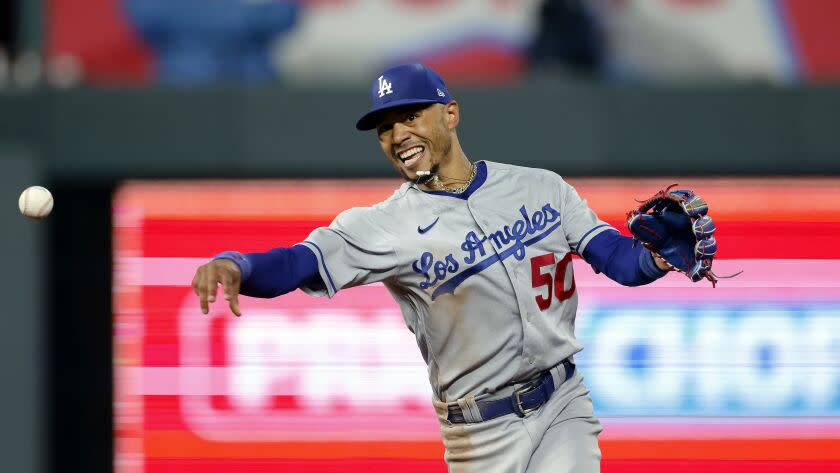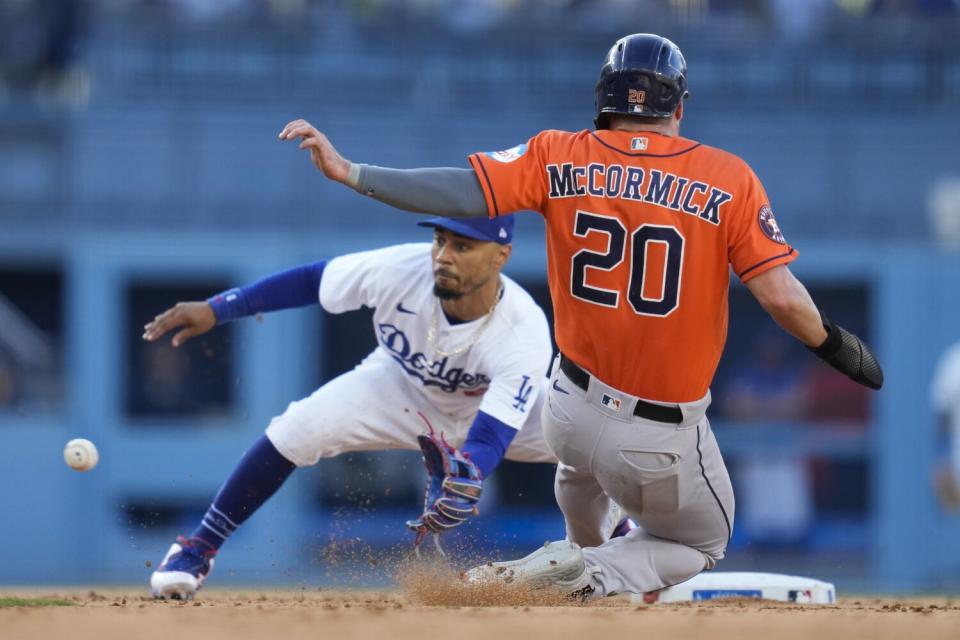'I've always considered myself a middle infielder.' How Mookie Betts excels beyond right field

Mookie Betts feels better than he has in a while. Getting past the nagging injuries that hindered him the last two seasons is reason No. 1. Reason No. 2 might seem frivolous: He’s running less on defense.
That is one of the benefits of playing more infield than ever before as a major leaguer. All those long jogs from right field to the dugout? Tracking all those balls in the outfield? He says that adds up and takes a toll.
“All the way out there and back 18 times,” Betts said last week, pointing to the Dodgers’ dugout and out to right field. “Then instead of me taking three steps to the right, backhand, boom, throw to first, you’ve got to take 30 at a full sprint. That in itself is an extra load.”
Read more: 'Sneaky pop.' How undersized Mookie Betts became baseball's unlikeliest home run slugger
Betts, 30, has played in 86 of the Dodgers’ 89 games this season. He has blasted 26 home runs with a .965 on-base-plus-slugging percentage as the club’s leadoff hitter. He became the second player in Major League Baseball history to register 10 leadoff home runs before the All-Star break. The power is more than his typical output — he’s just nine home runs shy of tying his career high — and has attracted most of the attention.
But Betts’ defensive versatility, although not on Shohei Ohtani’s unprecedented level, is otherwise unmatched for a player of his caliber. Just ask Ohtani, who went out of his way to compliment Betts when asked who impressed him the most in Tuesday's All-Star Game.
"Not just today, but watching guys overall, I feel like Mookie Betts really impresses me," Ohtani said after exiting the game "He’s so versatile."
Entering the season, Betts had started 30 games at second base in his major league career. He had never played shortstop. But he was an infielder as a kid into the minor leagues, and always wanted to return. He pushed to play more infield — first with the Boston Red Sox, then with the Dodgers — but there was never a pressing need. That changed this season.
Gavin Lux’s season-ending knee injury in spring training cut into the Dodgers’ already-thin infield depth. Utilityman Chris Taylor’s injuries and struggles cut into it some more. Add on offensive struggles from Miguel Vargas and Miguel Rojas, and the Dodgers calculated their best lineup against right-handed pitching was with left-handed hitters David Peralta and Jason Heyward manning the corner outfield sports and Betts in the infield.
As a result, Betts has made 12 starts at shortstop and 19 at second base. He has logged 254 total innings in the infield. He has played far more in right field — 54 starts and 482 ⅔ innings — but he has started in the infield in nine of the Dodgers’ last 13 games. He has posted three defensive runs saved at second base and none at shortstop, according to FanGraphs, suggesting that he has been at least average. It is not a gimmick.
If anything, the Dodgers’ decision to option Vargas to triple A on Sunday means Betts could play even more infield.
“I’ve never considered myself a right fielder,” Betts said. “I just play right field. I’ve always considered myself a middle infielder.”

Betts compared his season to summer ball growing up. One day he would play shortstop. Another second base. Another center field. He said it’s “normal” for him. It’s just not normal for anyone else at this level.
“He's much better than I expected,” Dodgers manager Dave Roberts said. “I knew that he could play second base. I didn't realize he could handle short the way he has. And, obviously, Shohei is the runaway MVP in baseball, but to have a guy that can play two middle infield spots, hit leadoff and be productive, what the value [is] for him for our ball club shouldn't be lost.”
This isn’t Little League. Betts wasn’t pushed to the outfield in the minor leagues because he was a bad defender. It happened because the Red Sox wanted to fit him on their big league roster. He turned out to be one of the few who could not only handle the switch but excel with the change.
Betts isn’t the quickest player. He doesn’t run the fastest. But his athleticism is elite. His hand-eye coordination, arm strength and arm accuracy are rivaled by few in the sport. He’s one of those people who is seemingly good at everything.
That talent effectively worked against him. He became too good in right field to return to the infield. He has won a Gold Glove in six of the last seven seasons. How do you justify moving one of the best outfielders in the world — one you’ve committed to pay $365 million — from the outfield?
“I get why,” Betts said. “We had Corey [Seager], we had Trea [Turner], we had Lux. We had other infielders. That’s cool. I wasn’t tripping. Plus they pay me to be an outfielder. I could have been an infielder my whole career. But it didn’t work out that way.”
Betts’ desire to play the infield never waned. He kept campaigning and he made sure he was ready for the opportunity, continuing to incorporate infield work in his pregame routine through the years.
Dodgers third base and infield coach Dino Ebel often leads those workouts. Betts, he said, asks for the routine ground balls, but he also wants the plays that aren’t routine. He wants to constantly hone his reaction. He asks Ebel to throw the ball in the dirt, up high, left, right. He wants choppers. He wants chances to pick it.
Ebel said he became convinced Betts could play shortstop in the majors last year. The veteran coach has been in professional baseball since 1988. The only other player he could think of in Betts’ stratosphere as a hitter who has shown his level of defensive versatility is Hall of Famer Robin Yount, who started his career as a shortstop before moving to center field.
“It's not easy, but he makes it look easy because he's a super athlete,” Ebel said of Betts. “He enjoys the challenge. When somebody says they don’t think he can do it, that's when he proves them wrong.”
Read more: The Dodgers are favorites to sign Shohei Ohtani. Will the third time be the charm?
Betts is often humble. He’s less so when he talks about his infield skills.
“I’ve been telling everybody I can do it,” Betts said.
Does he take any satisfaction in proving he can do it?
“No, because I believe in myself,” Betts said. “I know what I can do. If somebody doubted it, OK.”
What about the fact that his offensive numbers are significantly better this season when he plays the infield? He’s batting .347 with seven home runs and a 1.171 OPS in 87 plate appearances as a second baseman, .304 with three home runs and a 1.039 OPS in 52 plate appearances as a shortstop, and .243 with 16 home runs and an .874 OPS in 256 plate appearances as a right fielder.
“I think that’s just coincidence,” Betts said. “I mean, I was MVP playing right field.”
That’s true. He won AL MVP with Boston in 2018 playing just six innings in the infield. Five years later, he’s in the running to win another one with his defensive versatility atop his list of credentials, stretching the limits of what’s possible in the major leagues beyond anybody not named Shohei Ohtani.
Sign up for more Dodgers news with Dodgers Dugout. Delivered at the start of each series.
This story originally appeared in Los Angeles Times.

 Yahoo Sports
Yahoo Sports 